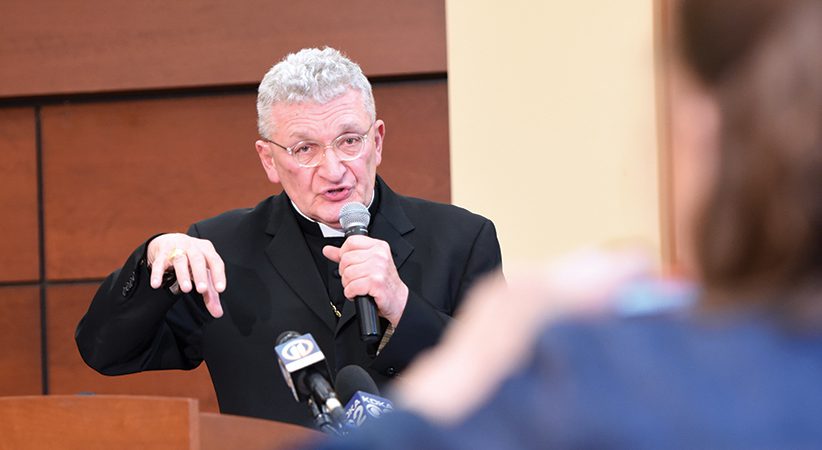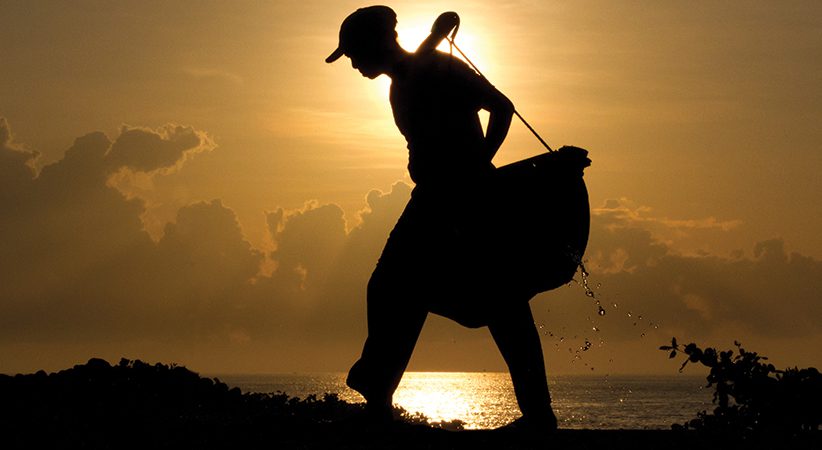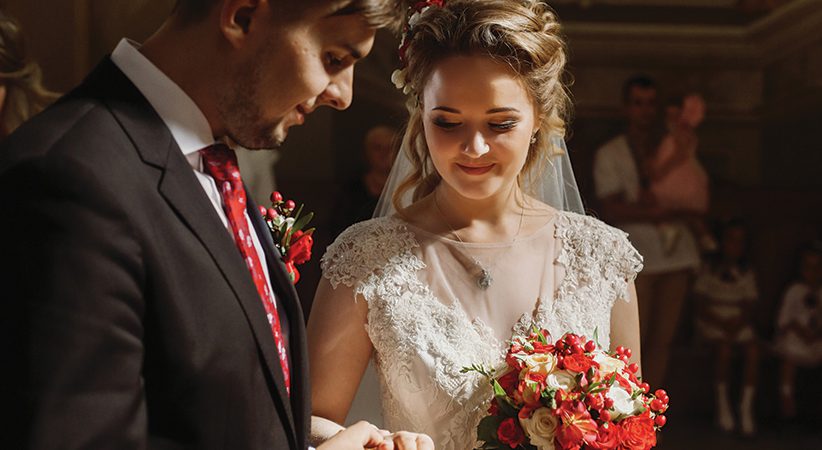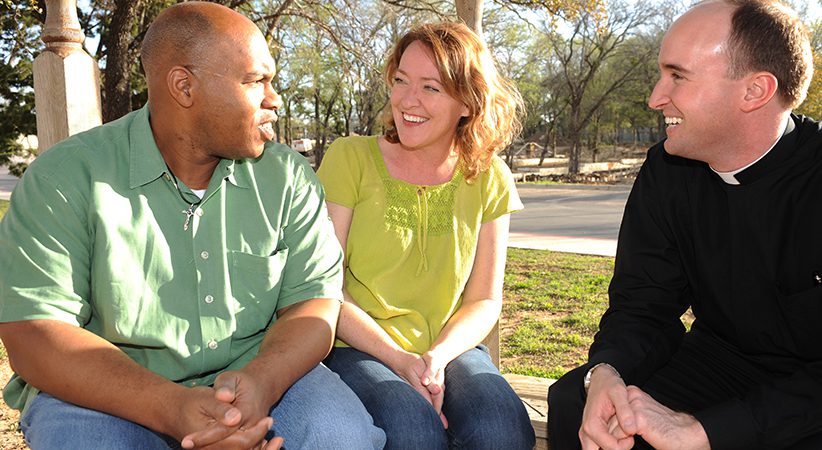Why Study Church History?
Effective catechesis includes focusing on salvation history, the unfolding of God’s plan
Steve Weidenkopf Comments Off on Why Study Church History?
Catechesis is a daunting task for today’s Catholic parish. There are limited resources — most especially time — and the challenge associated with the busyness and distractions of modern life. Despite the challenges, most pastors realize the importance of providing at least some level of instruction in the Faith to their flock.
Frequently, that instruction focuses on sacramental preparation, which is obviously crucial, but an argument can be easily made that the average Catholic in the pew needs continuing education in the Faith. Thankfully, many Catholic organizations have developed vibrant and engaging adult faith formation programs that pastors and their religious education teams can utilize to accomplish a certain level of catechesis. Usually, these programs focus on Scripture study, spirituality, apologetics or Church doctrine, which are all necessary objects of Catholic study and formation, but frequently missing is an emphasis on learning Church history.
There are many reasons for the lack of focus on learning Church history in the parish, including a dearth of catechetical materials, but a primary consideration centers on the popular perception of studying history. Frequently, the study of history appears as something mundane and tiresome because of how the subject is taught in today’s schools. Teaching history is often reduced to requiring students to memorize information — names, dates and events — with no meaningful link to their personal lives. The result is that students study history in order to pass tests and then quickly forget the material. History is viewed as another boring subject.
This pedagogical approach has greatly affected the number of students who choose history as their major academic program of study. Although Catholic parishes are not academic institutions, pastors can learn from the decline of history as a program of study. One chief lesson is how to market and host a parish’s catechetical program centered on learning Church history, including the best instructional approach.
Pastors must provide compelling answers to common questions about learning Church history, such as, what is history, why study it, and what lessons can be learned. Thankfully, there are persuasive answers to those questions!
………………………………………………………………………………………………………………………………………………………………………………..
‘Saepenumero considerantes,’ Letter on the Historical Sciences
In the summer of 1883, Pope Leo XIII (r. 1878-1903) issued a letter on historical sciences entitled Saepenumero considerantes. The pope used the letter to open the archives of the Vatican Library to researchers so that they could use primary sources and other documents in what he hoped would be an authentic narrative of Church history.
He was particularly irked that the enemies of the Church attacked her and the papacy with fallacious tales masqueraded as historical truth. Leo firmly believed false narratives would be refuted easily when scholars properly consulted and utilized the rich sources available in the Vatican Library.
The pope highlighted that anti-Catholic historical myths persist, among other reasons, because the Church’s enemies want to discredit and lessen her influence in the world. Leo recognized that many people are not malicious in discussing the Church’s history — they are merely repeating what they have heard or been taught.
Sometimes the real story is known by professionals and specialists in the field but has not filtered down to a mass audience. Leo also fretted that children are taught these falsehoods of Catholic history in school, which can threaten their faith since errors learned in youth are difficult to eradicate later in life.
The 19th-century pope’s concern for the learning of authentic Catholic history is still an issue more than a century later. It is incumbent upon modern-day Catholic historians, teachers and pastors to eradicate the lack of general knowledge about the Church’s rich history and contribution to human civilization.
— Steve Weidenkopf
…………………………………………………………………………………………………………………………………………………………………………………..
What Is History?
Most people are unaware that there is a Catholic understanding of history and it differs greatly from the ancient pagan understanding. Ancient Greek and Roman writers viewed history as a series of repetitive cycles with no beginning, central event or end; human events were bound to be repeated. However, for the Catholic, history is linear — it has a beginning and an end and is punctuated by climaxes. God oversees and is involved in human history. The sending of the God-Man provides proof of God’s love for humanity and his intimate involvement in human affairs.
Jesus Christ is the Lord of history and his Incarnation is the central event of human history. A Catholic understanding of history focuses on salvation history or the unfolding of God’s plan for his people, their sanctification and eventual union with him in heaven.
God’s act of creation begins salvation history, which will end with the Second Coming of Christ, who will usher forth a new heaven and a new earth. This divine dimension to human history forms a foundational element of studying Church history. It is not merely one subject among many; it is a way to grow deeper in relationship to the Holy Trinity by recognizing and discerning the spiritual meaning of human affairs.
Why Study History?
Learning Church history is vital for the modern-day Catholic for four primary reasons: to make sense of our world, to know Christ better, to defend the Faith and Church when attacked, and to build Catholic identity. Knowing the people, events and story of the Catholic Church provides meaning to the present age, which better assists us in shaping the future. Modern-day problems can be viewed with a deeper and more accurate perspective because of historical study.

Today’s Catholic must learn this worldview, as it is not common thinking in the current culture. Modern society focuses only on the present, often complex issues and policy decisions are condensed into 30-second sound bites. The focus on the present, Pope Benedict XVI said in an address in 2010 at the Meeting with Young People, is ultimately detrimental since it makes humanity “lose their sense of the past, of history; but by doing so it also deprives them of the ability to understand themselves, to perceive problems and to build the future.”
In Novo Millennio Ineunte, Pope John Paul II’s apostolic letter on the Great Jubilee of the Year 200, the pope wrote that since “Christ is the foundation and center of human history, [and] he is its meaning and ultimate goal,” studying Church history leads to greater knowledge of Jesus, which is the consummate goal of any Christian study. It can be difficult to see Christ in every event and human activity in Church history, especially when those actions are not in conformity with Jesus’ example and teachings, but he is always present through his Mystical Body. A study of Church history should deepen a relationship with Christ and the Church he founded.

Most Catholics in the United States learn history from a non-Catholic perspective because history is taught in the American educational system from an English Protestant perspective. There are many examples of this bias, but none more apparent than the people and events discussed when looking at 16th-century England. Most textbooks refer to Mary Tudor (r. 1553-58), the legitimate Catholic queen of England, as “Bloody Mary,” whereas, her half-sister (and illegitimate ruler) Elizabeth I (r. 1558-1603) is known as “Good Queen Bess” and one of England’s greatest monarchs.
The false anti-Catholic narrative taught about these women presents Mary as a bloodthirsty tyrant wickedly stamping out the Protestant faith of her people and Elizabeth as the strong “Virgin Queen,” who brought about an era of prosperity to the nation and was beloved because she exhibited her people’s strong Protestant convictions.
In reality, Mary was adored by her people and restored the Catholic faith (through an act of Parliament) to England after the schism and heresy embraced by her father (Henry VIII) and half-brother (Edward VI). Elizabeth was a figurehead — used and controlled by powerful men (especially William Cecil) behind the scenes. It was during her rule that the first state-sponsored persecution of the Catholic Church in Europe since the Roman Empire was undertaken.
……………………………………………………………………………………………………………………………………………………………………………..
Four Reasons to Learn Church History
Learning Church history is vital for the modern-day Catholic for four primary reasons:
• To make sense of our world.
• To know Christ better.
• To defend the Faith and Church when attacked.
• To build Catholic identity.
………………………………………………………………………………………………………………………………………………………………………………
Knowing the people, events and story of the Catholic Church provides meaning to the present age, which assists us in better shaping the future. Modern-day problems can then be viewed with a deeper and more accurate perspective because of historical study.
Under Elizabeth’s reign, her officials killed, tortured and imprisoned thousands of English subjects simply because they were Catholic. Unfortunately, that historical truth is rarely presented in today’s history classes. This is a prime example of why it’s vital for Catholics to learn Church history: to defend the Church when maligned, misrepresented and myths are presented as historical facts. Catholics have an obligation to defend the Church and embrace the truth about our historical past (both good and bad) and retake the historical narrative from the dominant Protestant (and increasingly, secular) view.
The Church continues Christ’s salvific mission, and each Catholic has a role to play in that important drama. Before we can play our part though, we need to know who we are — we must have a sense of Catholic identity. The modern Western world exhibits cultural and historical amnesia on a national level. Nations that separate themselves from their Christian origins are apt to embrace immoral and totalitarian political systems, which erode individual rights and place the individual at the service of the state.
In order to regain its identity, the West must relearn its Catholic history and hold high the supernatural and transcendent character of history — the recognition that God acts throughout human history. We must embrace what English historian Hilaire Belloc (1870-1953) termed “the Catholic conscience of history” wherein the Catholic understands the history of Western civilization from within precisely because it is the story of the Catholic Church and her influence on that civilization. Learning Church history from an authentic Catholic perspective should produce a deeper personal identity with the Church and lead to what German Cardinal Walter Brandmüller, former president of the Pontifical Committee for Historical Sciences, calls a “new, forceful consciousness of being Catholic.”
Christ, the master catechist, provides the best example on how to teach so that material will resonate with the intended audience. In the Gospels, Jesus spoke in a simple manner and told stories, which are one of the best ways to convey a teaching, because people remember stories. God is relational, and since human beings are made in his image and likeness, we are relational and live in relationships with other people — family, friends, co-workers, society, nation, etc. Relationships are built and reinforced through shared experiences and recounted later in stories. History is best taught and learned as a story. Indeed for most of human existence, history was conveyed through oral tradition (stories) and even when written down continued to be told in a narrative form.

Our Family History
Given the importance of learning Church history and the method in which it should be learned, we can ask another question: How should we view Church history? Christ revealed God to be a loving Father, and we are adopted sons and daughters in Christ and heirs to the kingdom of heaven.
When we study Church history, we focus on the actions and events of our brothers and sisters in the Faith. In essence, Church history is the study of our spiritual genealogy. Many people spend hours and resources tracing their earthly lineage, which is important, but even more important, since we hope to live with them in eternity, is the study of the history of our spiritual family. Viewing Church history in this manner helps prevent seeing history as a boring subject with no impact on our lives. Rather, Church history becomes the subject by which we grow in our Catholic identity, united with our faithful brothers and sisters, rooted in Christ and the Church he founded.
There is one central theme that runs throughout the 2,000-year history of the Church: persecution. This should be expected, as Christ warned that persecution would be the companion of the Christian (cf. Jn 15:20).
Sometimes that persecution manifested itself externally, such as in the bloody Roman persecutions of the early Church, and sometimes it was internal, such as with numerous heresies and schisms. Learning Church history helps us understand the reason for modern-day persecution and can provide solace, knowing the Church survived centuries of conflict and chaos.
Studying the lives of the men and women who came before us in the Faith also reinforces the reality that the Church is holy yet contains sinners. History is replete with men and women, gifted with free will, using that gift for good and for evil. Knowing the story of the heroes and villains of Church history provides examples of lives to emulate (saints) and actions to avoid.
Additionally, Church history provides encouragement in dealing with modern-day scandals and abuse. As the Church is in the midst of difficult times with revelations of episcopal corruption and scandal stemming from clerical sexual immorality, some Catholics may be tempted to despair over this knowledge of grave weakness, abuse and evil. However, Church history offers today’s Catholic a foundation to understand these events and potential consolation when recognizing similar (and even worse) events occurred in the past, which led to great reform and a reinvigorated Church.
Hopefully, the study of Church history leads to greater devotion to the Holy Spirit, who guides, guards and animates the Church. Despite the sinful actions of Christians throughout history, including from those occupying the highest office in the Church, the Church still stands. Despite attempts by secular empires, rulers and nations to destroy the Church and kill its members, the Church still stands. History does not record the end of the Church because it will not end until the Lord returns.
The continuation of the Church throughout human history is witness to the gift of the Holy Spirit as Hilaire Belloc noted: “When one remembers how the Catholic Church has been governed, and by whom, one realizes that it must be divinely inspired to have survived at all.”
Parish catechesis is a difficult but necessary task, and while most adult faith formation efforts emphasis Scripture study, it is time for pastors to focus on teaching our great family story to their flock (see sidebar for resources). The family of God faces a unique challenge in the modern world as secularization increases and Christian civilization recedes.
Much of the once-Christian West has rejected the Faith as those nominally identifying as Christian no longer practice the Faith even once or twice a year. This rejection of faith has led to declining populations and an increase in immorality resulting in concerted and sustained attacks against marriage, human sexuality and the dignity of the human person. Combatting this decline in Christian identity requires renewed discipleship to foster Christian living and a focused campaign on Christian education, the center of which must be learning the story of the Church.
Catholics must study and know Catholic history in order to defend the Church when those opposed to the Gospel attack her. Knowledge becomes most effective when shared with others. Today’s Catholics, enriched by the story of the Church and learning from the actions of the men and women, our brothers and sisters in the Lord, who have gone before us, can become the people of light the modern world desperately needs.
STEVE WEIDENKOPF teaches Church history at Christendom College Graduate School of Theology in Alexandria, Virginia. He is the author of “Timeless: A History of the Catholic Church” (2019), “The Glory of the Crusades” (2014), “The Real Story of Catholic History: Answering Twenty Centuries of Anti-Catholic Myths” (2017), and “20 Answers: The Reformation” (2017).
………………………………………………………………………………………………………………………………………………………………………………….
Parish Resources for the Study of Catholic History
“Timeless: A History of the Catholic Church” (OSV, $19.95), by Steve Weidenkopf, is a detailed narrative of the persons and main events that shaped the Church and Western civilization. Visit www.osvcatholicbookstore.com.
“Epic: A Journey through Church History” (Ascension Press, $194.95) is a 20-part DVD series, with accompanying workbook and timeline chart, that presents the 2,000-year history of the Church for group or private study. Visit ascensionpress.com.
“Epic: The Early Church” (Ascension Press, $129) is the second study in the “Epic” Church history series. A 10-part DVD study program, with accompanying workbook and timeline chart, focusing on the first 500 years of Church history as told through the lives of te saints and Christian heroes of the time. Visit ascensionpress.com.
“The Real Story of Catholic History: Answering Twenty Centuries of Anti-Catholic Myths” (Catholic Answers, $19.95) is a work of historical apologetics that answers 55 common anti-Catholic historical myths. The text provides a background to each myth, refutes it with authentic historical scholarship and provides an apologetics sound bite on how to answer the objection in conversation. Visit shop.catholic.com.
……………………………………………………………………………………………………………………………………………………………………………………





